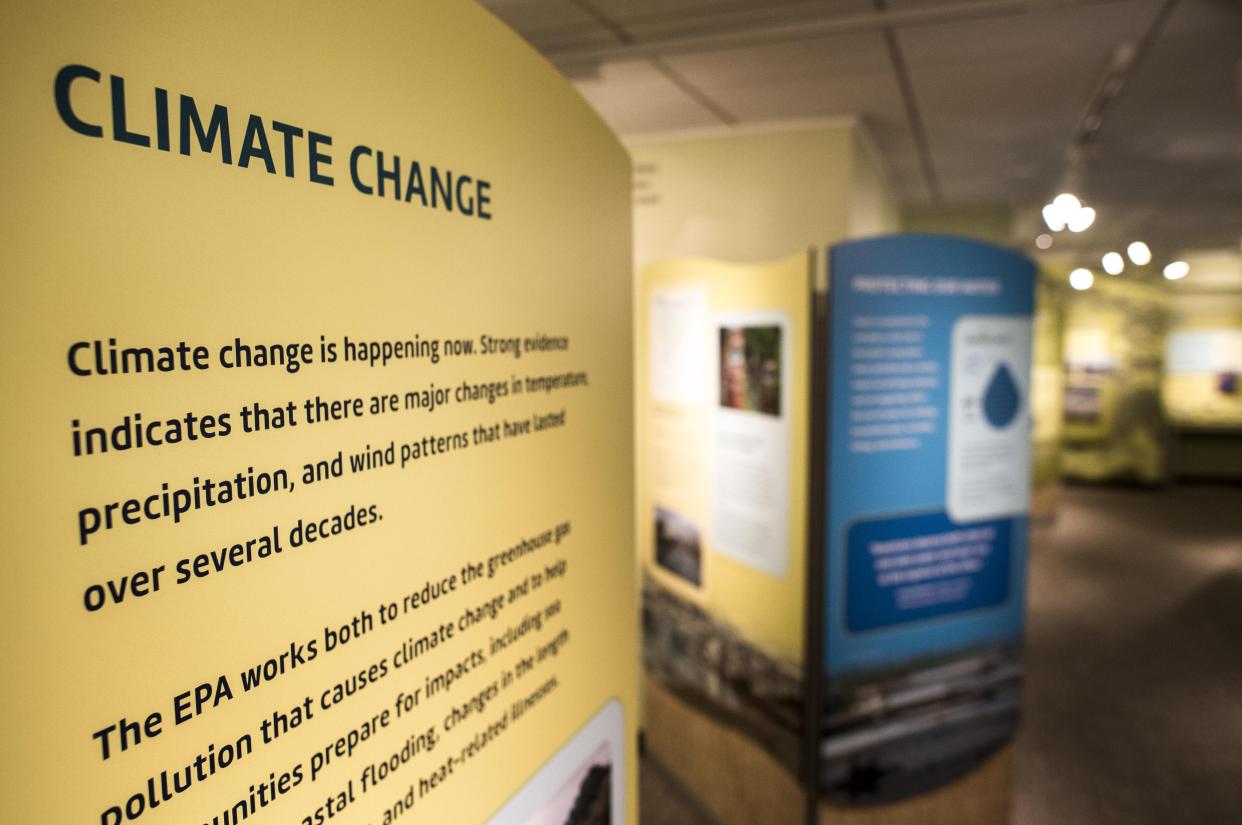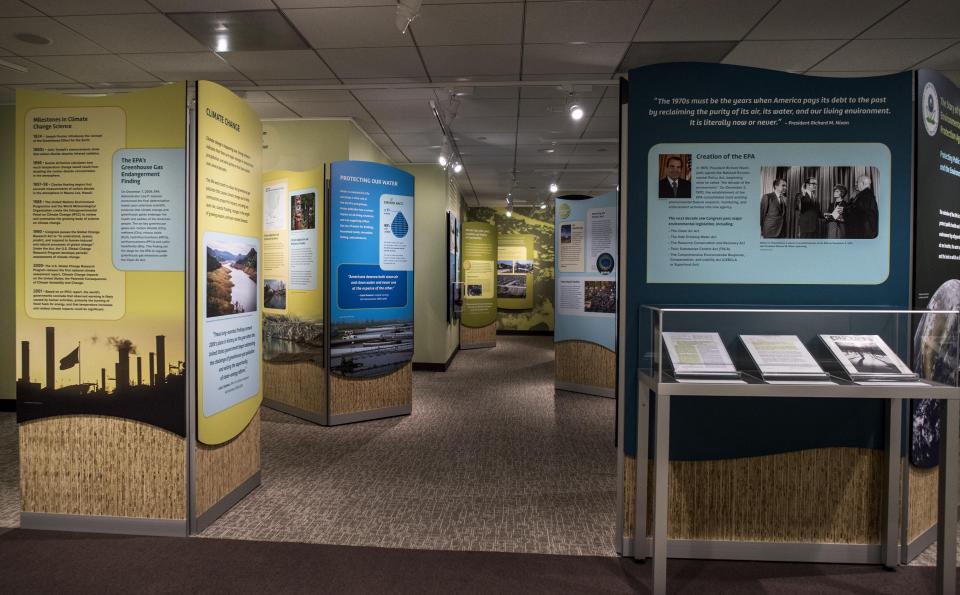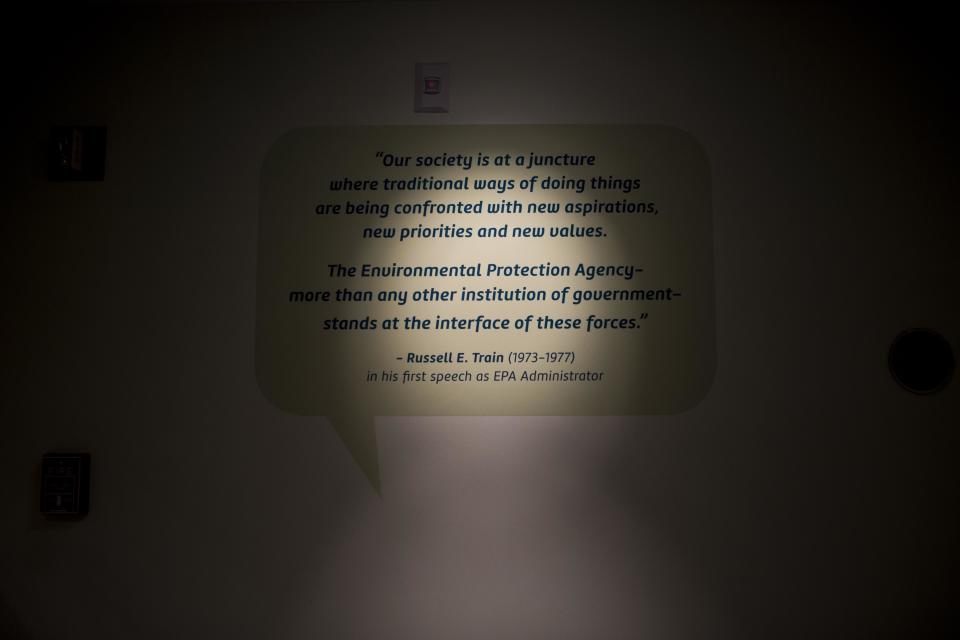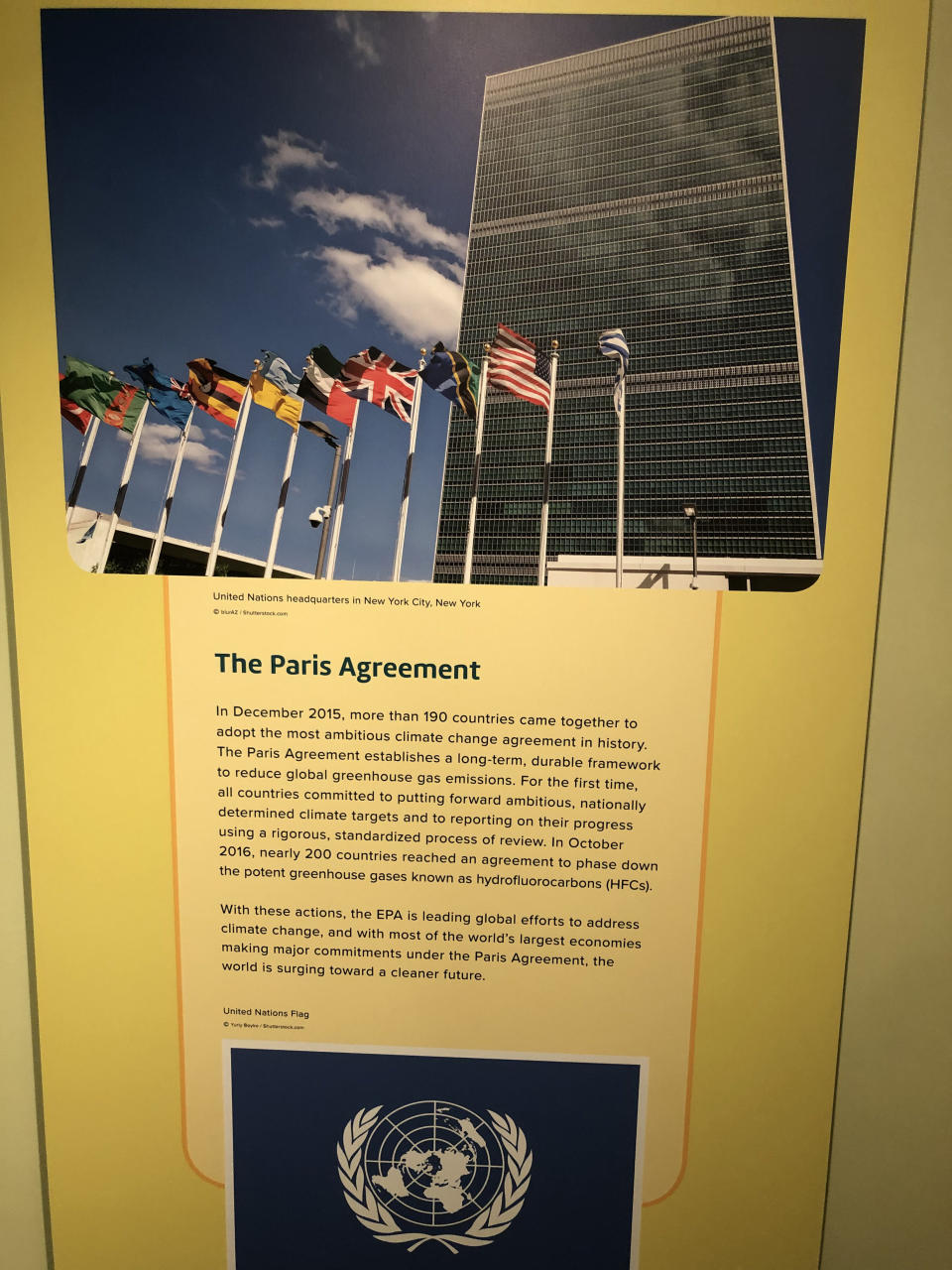Inside the EPA's 'resistance room,' where Trump was never president and climate change is real

WASHINGTON — No such thing. That was the verdict delivered by the security guard inside the Ronald Reagan Building on the question of whether there existed a museum of the Environmental Protection Agency and, more to the point, whether that museum was somewhere within this airy warren of federal offices in downtown Washington. In fact, she appeared to regard the question as downright insane.
Actually, there was — and is, as of this writing at least — such a thing as an EPA museum. The security guard looked on with annoyed concession as this reporter produced on his phone seemingly incontrovertible evidence that not only did an EPA museum exist in the reality-based community, it existed inside the Reagan Building, which is adjacent to the EPA’s headquarters (and just a few hundred feet from the Trump International Hotel).
The guard frowningly pointed the way. But it would be difficult to blame her, because in a city of temples to culture and the arts, “museum” evokes grandiose splendor, which is to say the exact opposite of “The Story of the Environmental Protection Agency: Protecting Public Health and the Environment,” as the EPA museum is formally known. To be fair, it does call itself an exhibit, not a museum, in a refreshingly modest turn in this town fueled by self-promotion.
Indeed, the repurposed office space next to the EPA’s credit union — which retains its gray carpeting, lime-colored walls and drop ceiling — is less museum than time machine, taking the visitor back to Nov. 8, 2016. That was before Donald Trump was elected president, before Trump’s EPA chief Scott Pruitt declared that “the war on coal is over.”
In fact, the only sign of the Trump administration is a framed photo of Andrew Wheeler, who became EPA head after Pruitt resigned in shame, as the number of investigations into his alleged personal and professional indiscretions rose to nearly 20. The photo was placed inconspicuously next to an ATM, which is not a museum exhibit but an apparent spillover from the employee credit union next door.

Far more notable is a text display — the exhibition is mostly text displays — on climate change. There are no Trumpian arguments about cyclical temperatures or scientific uncertainty. Instead, it very simply says that “climate change is happening now” and that it is caused by “greenhouse gas pollution.”
Trump, who once mused that global warming is a Chinese hoax, has continued to evince skepticism about the causes of rising temperatures, even as scientists warn of impending catastrophe. Wheeler has conceded that climate change is “an important issue,” but it has not been among his priorities.
The museum was opened by EPA administrator Gina McCarthy at the end of the Obama administration. The desire to start the museum “came from the career employees of the EPA,” says former EPA acting deputy administrator Stan Meiburg. Meiburg says that EPA staffers “chafed” at the fact that other federal agencies, including the Departments of Interior and Agriculture, had museums of their own.
“EPA had nothing — not at all,” Meiburg says. “And that just didn’t seem right.” A task force started working on plans for the museum in 2015. It opened in late 2016, while Obama was still president, and clearly reflects his conviction that climate change is an existential threat that could be mitigated by tougher environmental laws and a speedy transition to renewable sources of energy. For example, one panel notes the Obama administration restricted the “amount of toxic metals and other harmful pollutants that steam electric plants are allowed to discharge” in 2015. The panel makes no mention that, two years later, the Trump administration delayed implementing that rule while also canceling the Clean Power Plan, a major Obama initiative to shift away from fossil fuels.
It is remarkable that any of this still exists, considering how assiduously the Trump administration has moved to scrub the agency of its legacy. Mentions of climate change were removed from the EPA website in the months after Trump took office. The little museum, with no celebrities or billionaires on its board of directors, was supposed to meet the same fate.
In the summer of 2017, the Washington Post reported that the museum was “being reworked to reflect the priorities of the Trump administration” and that references to Obama-era green initiatives would be bowdlerized. “The agency may add a display of coal to the museum,” the Post said.
Pruitt didn’t get around to it. Wheeler is a more deft operative than Pruitt, but would a former coal lobbyist pass up a chance to extol fossil fuels, to push the narratives of clean coal and energy independence beloved by the Trump administration?
He has, so far. “We are not aware of any plans to add new displays to the exhibit,” an EPA official involved in the museum’s operations said.

That leaves the EPA museum a poignant reminder to what the agency once did. Only not many people are going there to be reminded. During the time this reporter spent there on a recent Wednesday afternoon, not a single other person visited. ("EPA never has much money for that sort of thing,” explains Meiburg about museum funding.)
But the visitors who do come — the EPA told Yahoo News it didn’t track attendance — discover that they’ve entered a United States that remains a party to the Paris climate accords, from which Trump indicated in 2017 he would withdraw, though that withdrawal cannot take place for several more years. At the EPA museum, no such withdrawal has taken place. Along with a photograph of the United Nations headquarters in New York, the display text about the Paris accords celebrates it as “the most ambitious climate change agreement in history.”
Another panel discusses the Toxic Substances Control Act, the 2016 legislation that sought to impose some regulatory order on the 80,000 chemicals used in everyday life. And while that law remains in place, the EPA’s own enforcement has waned in the Trump administration. That is in part because the EPA’s Office of Chemical Safety and Pollution Prevention was, until January, headed by Nancy Beck, a chemist who was formerly employed by the American Chemistry Council, a lobbying group for petrochemical and other corporations. Beck was called, as one headline put it, “The Scariest Trump Appointee You’ve Never Heard Of.”
Beck is not mentioned in the museum. Neither is Pruitt. Although the lotion-loving Oklahoman has been gone for nearly a year, nobody has seen fit to update the museum to include his tenure, which included the rollback of dozens of regulations at the behest of corporate benefactors. An interactive display that shows brief videos about previous EPA heads ends with the Obama administration.

Meiburg, the former EPA official, hopes that that does eventually change, with Pruitt and Wheeler included in the museum’s narrative. “The museum needs to tell the story as it was,” he says, to “deal with the hard things, as well as the easy things.” He notes that the museum covers the tenure of Anne Gorsuch Burford, the divisive conservative activist appointed to lead the agency in the 1980s. The EPA has survived her. And it has survived Pruitt.
But with scientists leaving the EPA in droves and corporate lobbyists finding plenty of time to meet with political appointees, experts believe it could be decades before the agency returns to what it was in 2016. If climatologists are right about rising ocean levels and the depleting ozone layer, the planet doesn’t have the luxury of decades to solve its ecological crises.
And so the EPA museum beats on, boat against the Trumpian current, borne back ceaselessly into the past. “EPA Runs on Green Power,” says a poster affixed near the entrance to the museum. That poster, which is not exactly a triumph of graphic design, shows several industrial-size windmills, which have become an increasingly popular source of electrical generation. Trump recently mused in a speech that such windmills cause cancer. They do not.

_____
Read more from Yahoo News:
Trump was ‘fighting for his political life,’ his former lawyer says
'It's already begun': Feedback loops will make climate change even worse, scientists say
Revealed: The U.S. military's 36 code-named operations in Africa
Video shows extensive fire damage inside Notre Dame Cathedral
Concerns mount over Jared Kushner's role in GOP money machine



